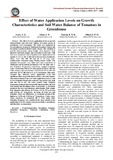Effects of Water Application Levels on Growth Characteristics and Soil Water Balance of Tomatoes in Greenhouse

View/
Date
2014Author
Njoroge, BNK
Obiero J. P. O
Type
ArticleLanguage
enMetadata
Show full item recordAbstract
Abstract - The effect of water application levels on growth
characteristics and soil water balance of tomato grown in
greenhouse were investigated. The study was conducted in
two greenhouses located at Matinyani Secondary School and
Kyondoni Location in Kitui County, Kenya. The variation of
growth characteristics (plant height, stem diameter, fruit
diameter and fruit weight) and extraction of soil water with
time were monitored. Four irrigation water application levels
namely T1-1.2, T2-1.0, T3-0.8 and T4-0.6 served as treatments.
These were 120, 100, 80 and 60 % of crop water
requirements computed using Piestley-Taylor model. The
irrigation frequencies were daily and 1-day respectively at
Matinyani and Kyondoni greenhouses. For the daily and 1day
irrigation frequencies respectively, applied irrigation
water varied from 548 to 274 mm and from 255 to 128 mm
while actual evapotranspiration varied from 537 to 246 mm
and from 227 to 108 mm in T1 to T4 treatments. This study
revealed that different water application levels had
significant effect on growth characteristics, soil water balance
and yield of tomato crop. Low water application levels as well
as less irrigation frequencies reduced crop growth and yield
and also led to low soil water content. Daily irrigated
treatments produced the best growth characteristics, the best
fruit quality and the highest yield. In particular, T1 treatment
produced the best stem diameter, plant height, fruit weight,
fruit diameter and yield as 16.74 mm, 2.31 m, 129 g, 62 mm
and 4.44 kg m-2 respectively. In terms of water use and
irrigation water use efficiencies, T4 treatment produced the
highest as 11.90 and 13.26 kg m-3 respectively. Under scarce
water resources, T3 treatment (80 % ETc) under daily
irrigation frequency was considered the most suitable water
application level for tomato crop grown inside a greenhouse
and therefore recommended.
Keywords – Evapotranspiration, Greenhouse Farming,
Irrigation Frequency, Protected Cultivation, Water
Resources.
URI
http://hdl.handle.net/11295/71623http://search.proquest.com/openview/0f74d8555f331bad112c95b9a55cc6d7/1.pdf?pq-origsite=gscholar&cbl=2034499
Citation
Njoroge BNK, N. GA, O. OJP. "Effects of Water Application Levels on Growth Characteristics and Soil Water Balance of Tomatoes in Greenhouse." International Journal of Engineering Innovation & Research . 2014;Volume 3(Issue3):ISSN: 2277-5668.Publisher
University of Nairobi
Collections
- Faculty of Education (FEd) [1042]
